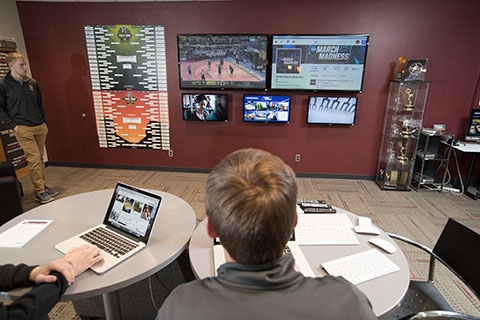You have /5 articles left.
Sign up for a free account or log in.

Students monitor NCAA basketball tournament games and write social media posts at Ball State's digital sports production center.
Ball State University
While college basketball fans across the country are focused on the NCAA men’s and women’s basketball tournaments this month, several dozen Ball State University students have been immersed in their own brand of March Madness.
In a continuing educational partnership with the NCAA’s digital and social media department, 40 undergraduates are assisting in the operation of social media curation, engagement and digital content production for the men’s and women’s games.
Since the annual tournaments began in mid-March, the group of undergrads has helped feed the NCAA’s Twitter accounts by monitoring social media posts about the Division I games and curating relevant content. For each of 132 men’s and women’s games, students in the school’s SportsLink digital sports production program scour social media including Twitter, Facebook and Instagram for content to place on various NCAA Twitter accounts, including @FinalFour and @ncaawbb.
While the gig may sound like something any American teenager could do, it involves more than just random tweeting, said Chris Taylor, Ball State’s digital sports production director. The students search for and highlight carefully selected programming that is of high interest to fans, such as player stats, traffic and parking advisories around games and special promotions. They curate, filter and respond to content and operate an array of social media tools to provide fans the best possible experience, he said.
The action takes place in a 1,500-square-foot state-of-the-art building on the school’s Muncie, Ind., campus. The production center in the Ball Communication Building uses the same digital programming workflows and systems as sports media powerhouses such as Turner Sports and ESPN.
By the end of the tournaments in early April, the Ball State Twitter team will have watched more than 300 hours of games and promoted tens of millions of tweets, Taylor said. The students don’t get paid, but they get course credit and invaluable hands-on experience in a burgeoning field.
The NCAA program costs Ball State nothing because the students use existing equipment, Taylor said -- and the returns are priceless. “It’s really an invaluable experience for our students to be able to be involved in something like this,” he added.
It’s a great experience -- and a lot of fun, too, said Ball State junior Matt Craig, who has worked on the project for the past two years.
“In the sports media industry you just can't learn everything you need to know in the classroom, so experiences like these are essential to our education,” Craig said. “And then professionally, it looks great on your résumé to be able to show that you've worked in a high-stakes, professional environment. Organizations know they can trust you to distribute on large platforms, and work well with corporate sponsors.”
The program began six years ago through connections Taylor and another Ball State alumnus had with the NCAA and Turner Broadcasting, Taylor said. The partnership builds on the creation of a digital externship—now in its third year—between the NCAA and Sports Link.
“Not only does [the program] provide our social media platforms with valuable content, it also gives the next generation of content producers firsthand experience,” said Nate Flannery, director of NCAA Digital and Social Media, Championships and Alliances.
An Immersion Approach
Sports Link is the country’s first fully immersive digital sports production program, and it differs from sports journalism and sports broadcasting programs available at other colleges, Taylor said. Students produce a broad range of content from live remote productions, live-to-tape events, television programs, student-athlete features, Facebook Live shows and social media content creation. Other facets of the program include a radio station, social media management and analytics, podcasts and the use of mobile technology and interactivity via the web, he said.
The program is part of the university’s Telecommunications major, which includes other areas of study such as digital audio production, digital video production, film and media studies and news. About 15 students are selected for the digital sports production program each year, Taylor said.
The school began offering classes in digital sports production seven years ago and in 2013 made it an academic track. The first cohort of students who chose the major is graduating this spring.
The digital sports production director is bullish about the soon-to-be-graduates’ future prospects. “We’re seeing the job track just explode,” he said. “The production and sports media industries are just really growing.”
In fact, Taylor said that media production is booming in other areas such as political news coverage, entertainment and breaking news, as more Americans take to watching a “second screen” while viewing television.
“Being able to curate in real time for social media is a skill set that’s very much wanted these days,” he said.







